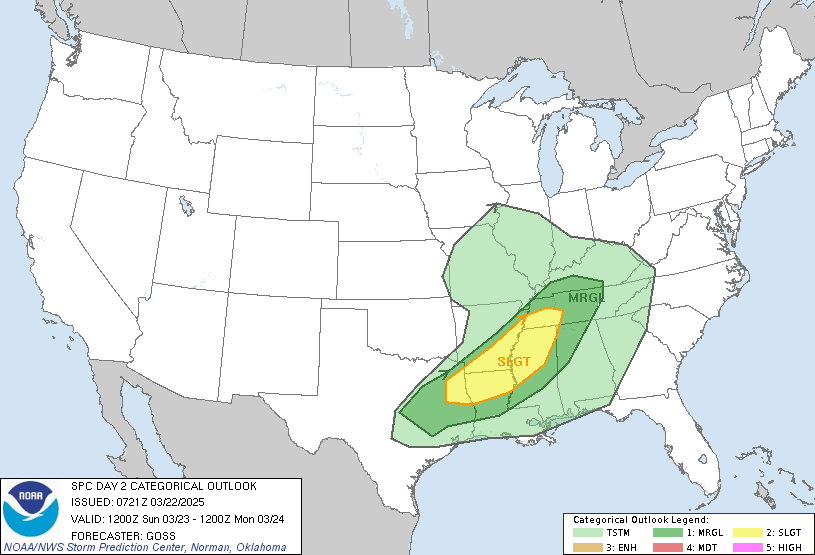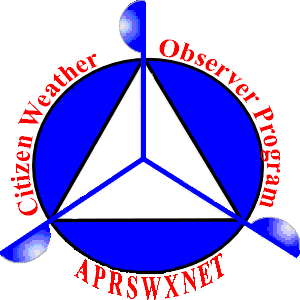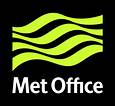|
|

Categorical Day2 0700Z Outlook
|
|

Probability of severe weather within 25 miles of a point.
Hatched Area: 10% or greater probability of significant severe weather within 25 miles of a point.
|
|
|
Images courtesy of the NWS Storm Prediction Center
000
ACUS02 KWNS 260552
SWODY2
SPC AC 260550
Day 2 Convective Outlook
NWS Storm Prediction Center Norman OK
1250 AM CDT Fri Apr 26 2024
Valid 271200Z - 281200Z
...THERE IS AN ENHANCED RISK OF SEVERE THUNDERSTORMS FOR MUCH OF
OK...PARTS OF NORTH TX...CENTRAL/EASTERN KS...NORTHWEST
MO...SOUTHEAST NE...SOUTHWEST IA...
...SUMMARY...
Potentially widespread strong to severe thunderstorms are expected
Saturday into Saturday night. The greatest threat is currently
anticipated across parts of the central and southern Plains, where
very large hail, damaging winds, and a few strong tornadoes will be
possible. A larger area of potential threat will extend from
south-central Texas north-northeastward into the Great Lakes.
...Synopsis...
A shortwave trough and attendant surface low are forecast to
gradually weaken and move northeastward across the upper Great Lakes
region on Saturday. Meanwhile, a deep mid/upper-level trough will
move eastward from the Southwest, resulting in a deepening cyclone
across southwest KS. Rich low-level moisture will continue to stream
northward across the warm sector of this cyclone, and extend
northeastward along/ahead of the front into parts of the upper
Midwest and Great Lakes.
...Central/southern Great Plains...
A complex but potentially significant severe weather episode is
expected on Saturday, with the greatest threat currently expected
from parts of central/eastern KS into central/western OK and north
TX. All severe hazards will be possible, including the threat for
strong tornadoes and very large hail.
Evolution of the warm sector and storm development on Saturday will
be complicated by the potential for early-day convection spreading
northeastward from northwest TX through OK into eastern KS. This
convection would likely initiate late in the D1/Friday period as
low-level moisture streams westward in conjunction with a retreating
dryline, beneath steep midlevel lapse rates. While most guidance
depicts some sort of early convection, its forecast evolution varies
widely among both CAMs and parameterized convection within mesoscale
and global models. Some severe threat could accompany this
convection as it moves northeastward through the day.
Strong low-level southerly flow will support recovery in the wake of
any morning convection. Diurnal storm development will be possible
in the vicinity of the dryline and also near a northward-moving warm
front extending east-northeast from the deepening cyclone.
For the dryline regime, supercell development will become
increasingly possible by late afternoon, as MLCINH diminishes and
some influence of the approaching upper trough begins to overspread
the region. Moderate to strong buoyancy and strengthening deep-layer
shear will support an initial threat of very large hail (potentially
2-3 inches in diameter). The tornado threat will increase into early
evening, due to a notable increase in the low-level jet (and related
shear/SRH) with time and eastward extent. Any persistent supercells
will pose a threat of strong to potentially intense tornadoes as
they move northeastward. Dryline storm initiation may be somewhat
greater in coverage from west-central KS into northwest OK, in
closer proximity to stronger large-scale ascent, though at least
isolated development will be possible into southwest OK and
northwest TX.
For the warm-front regime, initial development may tend to be
focused near the dryline/front intersection across north-central KS,
with more isolated initiation possible northeastward along the front
as capping is gradually eroded. Moderate to strong buoyancy and
favorable low-level and deep-layer shear will support supercell
potential within this regime. All severe hazards will be possible,
including the potential for very large hail and a strong tornado.
With time, increasing storm coverage will likely halt the northward
progression of the warm front, with one or more storm clusters
moving near/north of the front through the evening with a continued
severe threat.
Aside from the dryline and warm-frontal regimes, diurnal development
across the broader warm sector will be possible within a moist and
weakly capped environment, particularly from central OK into eastern
KS. Evolution and coverage of diurnal warm sector development remain
uncertain, but the environment will support supercell development
with a threat of tornadoes and very large hail.
Storm coverage will likely increase into the evening, as large-scale
ascent attendant to the approaching shortwave trough overspreads the
region. Convection may tend to organized into a QLCS overnight.
While magnitude of the severe threat with overnight convection
remains uncertain, favorable moisture and a strong low-level jet may
continue to support at least some threat for all severe hazards,
both within the warm sector and eventually along a trailing cold
front into parts of central/southwest TX.
...Northwest KS/southwest NE into northeast CO...
Low-level easterly flow will maintain modest low-level moisture
within the post-frontal regime from northwest KS/southwest NE into
northeast CO. Steep midlevel lapse rates will support MLCAPE
increasing to near/above 500 J/kg, with veering wind profiles
supporting potential for organized convection. A supercell or two
could evolve within this regime, with an attendant threat of large
hail and possibly a brief tornado.
...Parts of the Upper Midwest/Great Lakes...
A separate regime of at least isolated severe-thunderstorm potential
remains evident along/ahead of the cold front from eastern IA into
parts of the Great Lakes region. While the influence of the ejecting
shortwave trough initially over the Upper Great Lakes may remain
mostly displaced from the warm sector, diurnal
heating/destabilization and decreasing CINH may support isolated
storm development by late afternoon along the cold front. Deep-layer
shear will remain sufficient for organized convection, supporting
conditional potential for supercells and/or stronger clusters
capable of producing hail, damaging gusts, and possibly a tornado or
two.
Some increase in storm coverage will be possible into the evening as
the cold front moves southeastward. Eventually, convection should
generally weaken overnight across this region, though a stronger
cluster to two could move from eastern portions of the central
Plains toward the upper MS Valley before the end of the forecast
period.
..Dean.. 04/26/2024
$$







